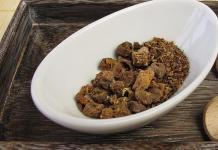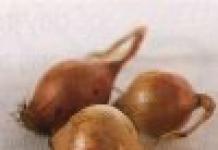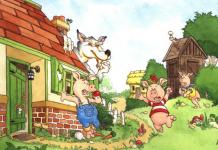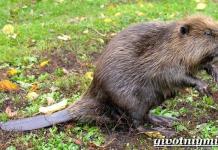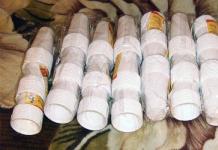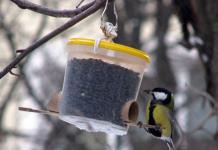One of the first crops that gardeners begin to plant is onions. This plant has a large varietal selection, which very often confuses novice gardeners and gardeners. After all, it can be quite difficult to choose a plant without knowing its characteristics. In this article, we'll take a look at the very best onion sets.
How to choose a good set
Before choosing a sevok, which will subsequently be planted, you need to make sure that it really is a good choice... You can buy a set in a store or prepare it yourself. But in any case, it is necessary to proceed from the criteria for choosing a suitable seedling.
Sevka selection criteria:
- taste characteristics. First of all, you should start your choice with this parameter, because it is because of this that onions are grown;
- the form. This criterion depends only on varietal variety and taste characteristics. After all, few people will plant onions just because they are round;
- resistance of the variety to temperature indicators, as well as humidity. Onion sets respond to these factors by reducing their growth activity. Therefore, remember that the more the onion is transported, fiddled with, the earlier it will start growing and start to sprout;
- the smell emanating from the bulbs should be characteristic of the onion. There should be no smell of rot, dampness, mold;
- good specimens should have a small amount of dried onions (no more than 1%);
- the dried onions should rustle. This is a sign of a good set;
- all bulbs must correspond in shape and color to the characteristics of the selected variety;
- appearance... The bulbs must be firm and flat. They should be free from traces of diseases, pests, rot or deterioration;
- the color of the bulbs should be uniform, without various spots;
- the sevka should be free of any mechanical damage;
- the bulbs must be dry. In case of contact with wet specimens (their color is slightly darker), it will be enough just to dry them;
- the seller must indicate the exact name of the variety, as well as its characteristics and shelf life. This is a necessary condition, since the varieties of onion sets have different species parameters, on which germination and yield directly depend. These parameters should also be indicated on the packaging.
In addition to these criteria, not the least is the size of the bulbs. Sevki according to this indicator are divided into the following groups:
- small-breeding varieties. This group includes plants with a bulb size of 10-15 mm. These bulbs can be planted before winter;
- medium-sized varieties. The group includes plants with bulbs of sizes 15.1-22 mm;
- multi-nested varieties. This includes onions with bulb sizes ranging from 22.1 to 40 mm.
There is another classification of onion sets according to their size:
- fine fraction - 8-14 mm. The most optimal size for winter planting. This fraction is not suitable for spring planting. Their bulbs do not give arrows. However, due to their small size, such sets often freeze out. Plants with such bulbs can be three weeks behind in maturity from the seedlings of the middle fraction. When planted on nutrient-poor soils, forms small bulbs;
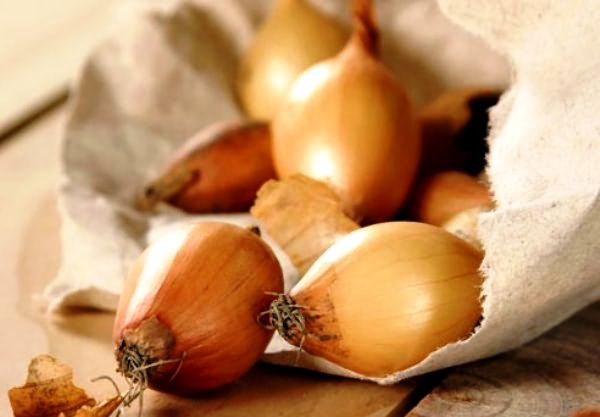
- the middle fraction is 14–21 mm. Often used for winter planting. Bulbs also do not form an arrow. Optimal size for spring planting;
- large fraction - 21-24 mm. It is used for sub-winter planting and is planted only to obtain greenery. In the case of spring planting, it can form arrows (some varieties give in case of early planting or improper storage). A big plus of this fraction is that ripening and harvesting are guaranteed. This fraction is advised to be planted by the most novice and inexperienced gardeners;
- coarse fraction - 24-30 mm. This fraction appeared on the market relatively recently. The advantage of this group is the low stage. It is used for winter planting and only for obtaining greenery. Spring planting is carried out similarly to the previous fractions;
- very coarse fraction - 30–40 mm. Used to get greenery. No arrows, but only if stored properly. Experts recommend warming the bulbs before planting the soil.
Today on the market you can find sets and larger sizes. But these bulbs have a high probability of shooting. This bow is not very suitable for planting.
The use of sevka of one fraction has the following advantages:
- high uniformity of planting material;
- when using a homogeneous planting material, an increase in yield growth occurs up to 20%;
- the onion grows to a predictable size;
- the maximum correlation of the ripening dates of the plant is ensured.
Therefore, the choice of onion sets should be carried out depending on the planting time and its purpose. The most optimal size of the bulbs for their further normal growth is 1-2 cm.
Benefits of using sevka instead of seeds:
- the opportunity to get a harvest much earlier;
- the culture has a faster development, which has a positive effect on the quality of the crop itself at the end of the growing season;
- the plant has a stronger and more powerful root system. This property is of great importance when growing plants in arid soils;
- plants grown from seedlings are less susceptible to the negative influence of weeds;
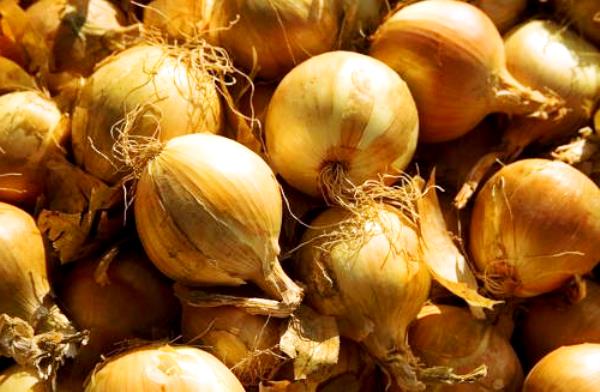
- in the case of growing onions on light soils, the loss of yield due to wind erosion is minimal;
- onions tolerate mechanical processing well.
The choice of onion sets should be approached thoroughly, since the yield and growth rate of plants depend on this stage.
The best varieties
In addition to the choice of good planting material, not the last place in horticulture and horticulture is the choice of the variety of onion sets. They differ from one another in terms of basic characteristics, as well as ripening time, price and yield.
Description of the most popular onion varieties that are used as sets:
- Sturon is considered one of the best varieties of onions. Early ripening is characteristic. The onion has a semi-sharp pleasant taste. Its bulbs are medium to large in size. They are unilocular. The mass of one onion ranges from 90-100 to 140-150 grams. The variety has a stable and excellent germination and productivity. Not used for growing on greens. The advantage of this variety is that the harvest is carried out 8 or even 12 days earlier than other plants. Grown in northern latitudes (Russia, Northern Europe, Scandinavia). Highly resistant to various diseases... Grown commercially. Long-term storage onions;
- Stuttgarter Riesen is the most famous early ripening variety. It grows in our area. The bulbs are medium to large in size. They are flat or flat-round, dense in consistency. Possesses a pronounced pungent taste. The mass of one onion is from 50–94 to 150–300 g. Contains a large number of vitamin C. Reproduction is possible by seedlings, seedlings and seeds. A significant disadvantage of the plant is its susceptibility to diseases such as downy mildew and neck rot. High yield, germination and excellent keeping quality. Plastic variety, picky about watering, loosening and weeding. Bulbs are stored for up to 6 months;
- Centurion. It is a new selection variety of Stuttgarter Riesen. The shape of the bulb is uniform and elongated. The mass of one bulb is about 110–150 g (it can reach 180 g). Bulbs keep well (up to 8 months). The taste is spicy or semi-sharp. Under favorable conditions, 100% germination is possible. The yield is high. The variety is resistant to most diseases. Grown for sevka, but not for greens. Characterized by high resistance to shooting, increased keeping quality. Grown commercially;
- Hercules. A mid-early hybrid with one of the largest round bulbs. Grows well throughout Russia. The shape of the bulbs is broadly elliptical, and the mass is about 160 g. The taste is spicy. High yield is described. The variety keeps well. The plant is resistant to fusarium onion, bottom rot, pink rot;

- Red Baron. Excellent early variety of red / purple onions. The bulb is round and has a mass from 25-40 to 130-150 g. They are well stored. The taste of the bulbs is pleasant and semi-sharp. It is appreciated for its stable yield and excellent ripening properties. Requires regular watering, loosening and weeding. Propagated by seedlings, seedlings and seeds. Due to its excellent taste, it is often included in salads or used in fresh.
In addition to these varieties, there are other fairly widespread varieties:
- Shtur BS-20. Medium late new variety. Its bulbs have a smooth, rounded shape. They contain a lot of dry matter. The husk is yellow. Long-term preservation is characteristic;
- Orion. Exclusive early maturing hybrid English variety. Produces perfectly round and large bulbs. Their weight is about 150-200 g. It is well stored. This variety is especially preferred by gardeners;
- Stardust. Medium early grade. The bulbs have a pleasant and semi-sharp taste. Good germination and productivity are described. They are smooth and round in shape, large in size. The mass of one bulb is about 30-50 g. Propagated by seeds and seedlings. Can be stored for a long time;

- Carmen. A variety of red onions. The taste of the bulbs is weak. They are of medium density and rounded, which is slightly flattened. Contains a lot of vitamin C and dry matter. The mass of one onion ranges from 50-80 to 100-120 g. 90-100% ripening and good keeping quality are described. Propagated by seedlings, seeds and seedlings;
- Chalcedony. Mid-season variety. The bulbs have a pungent taste. The mass of one onion is 85-100 g. Good keeping quality is described. It is affected by small rot, but is resistant to peronosporosis, cervical rot. It is also grown for greenery. A variety of universal use.
- Ellan. An early elite variety. The bulb is round or elongated. Bulb weight up to 300 g. Resistant to various pests and diseases.
As you can see, the choice of varieties of onion sets is truly huge. Among this variety, every gardener will be able to find the most suitable variety for himself, or even several varieties.
Video "Varieties of onion sets"
In the video, an overview of the most popular varieties of onion sets. a brief description of varieties, criteria for choosing bulbs for planting, tips for planting.
plodovie.ru
Onion sets. Varieties, cultivation, planting scheme
To get a good harvest of onions, experienced gardeners grow onion sets in advance. The advantage of this method is that more hardy plants are obtained from the seedlings, which are rarely exposed to diseases, are less demanding on soil and care, and ripen quickly. 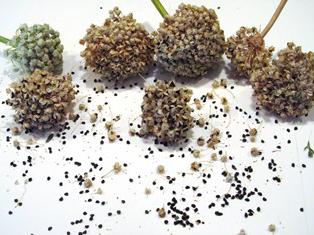
Growing onions from sets begins with sowing nigella, as onion seeds are popularly called.
Preparing the soil for sowing onion seeds
Growing seedlings from seeds primarily concerns early, mid-early and sharp onion varieties and is divided into several stages:
- It is necessary to prepare the soil - to free it from weeds and fertilize it in autumn with rotted manure or compost, and if the soil is acidic, treat it with lime. The best place for sowing seeds, the sunny side of the site will be.
- As soon as the ground starts to warm up, you need to prepare the seeds for sowing. To do this, they are soaked in water for a day so that they swell and hatch. This will speed up the germination process.
The most favorable time for sowing seeds for sowing is when the earth warms up enough and the threat of frost passes. In order for the seedlings to come out faster, you need to cover them with a film, which will also save the crop from accidental morning frost.
Sowing scheme for onion seeds
In order not to thin out the germinated seeds, it is better to do all the work right before sowing right away. The seeding scheme is simple:
- In the dug up and carefully loosened earth, it is necessary to make furrows up to 2 cm deep at a distance of up to 30 cm between them.
- Onion sets (nigella) are sown at a distance of 0.5-2 cm from each other, which allows seedlings to emerge and develop in full force... If the seeds are rarely sown, then a large seed will grow, which, upon further planting, will go not to growth, but to shooting.
- Caring for a seedbed consists of regularly loosening the soil, watering by sprinkling and killing weeds.
The best bed for growing sevka will be the place where tomatoes, potatoes, cucumbers or cabbage were previously grown.
Collection of onion sets
You can determine the time when to remove the onion sets by its leaves. In July, they begin to lie down and dry out. You should not wait for complete lodging or wilting, otherwise, during harvesting, dry feathers will come off, and the bulbs themselves will get stuck in the ground.
Collecting sevka should be done in dry weather and not be late with harvesting. If it rains, the onions will take root and grow further, which will be a problem for the entire crop. Such a set is difficult to dry and there is a threat of rotting.
It is better to start harvesting seedlings with still green leaves, which will not in any way affect its quality as a planting material, than to risk a delay in harvesting. The only difficulty is that drying will take longer than digging out plants with lodging tops.
The harvesting process is quite simple - the bulbs are pulled out of the ground and put in a well-ventilated and sunny place to dry. If the seed still has green leaves, then under the influence of heat and sun nutrients pass from them into the onion, which makes it larger, juicier and tastier. As soon as the leaves and "neck" are completely dry, it becomes clear when to put onion sets for storage indoors.
Varieties of onion sets
It depends on the seeds not only how high the harvest will be, but also how quickly it will be possible to grow it. Experienced gardeners plant onion sets, the varieties of which are tested for the quality of the final product and its quantity. These include:
- Timiryazevsky... The variety has a pungent taste, good storage characteristics, early maturity, gives up to 3 bulbs per 1 nest.
- Strigunovsky known for its suitability for growing turnip onions from seed in one year. Produces up to 2 bulbs per nest when grown from seedlings, has a pungent taste, round shape in yellow husks.
- Bessonovsky onion sets are revered by many gardeners for the property of giving from 3 to 5 bulbs of spicy taste with excellent keeping quality.
- Variety Svirsky has rounded, slightly flattened bulbs, belongs to mid-season and semi-sharp in taste varieties. Produces 1 or 2 bulbs per nest.
- Danilovsky-301 It stands out for its purple scales, has a round-flat shape, semi-sharp taste and gives 1 onion per nest. Can be grown from seed in one year.
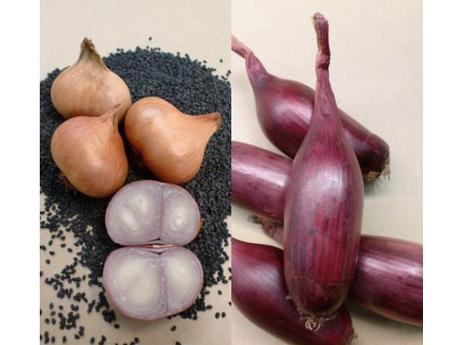
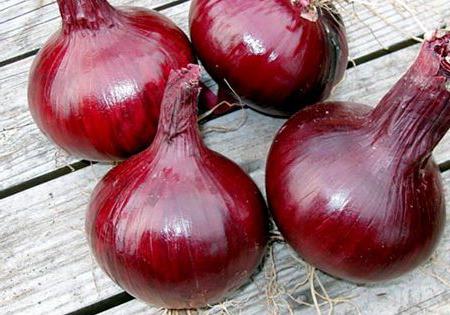
These onion varieties are most often preferred by gardeners on their plots. All of them are perfectly preserved until next year, give a high yield and have excellent taste.
Preparing onion sets for planting
To get a bountiful harvest of onions, you should not only properly prepare, but also select a suitable onion set in advance. Landing in the right place at the right time also plays an important role. The whole process can be divided into several stages:
- All onions should be divided in advance by size and rotted specimens should be removed. If you plant at the same time "different-sized" onion sets, then its germination will be uneven, which will complicate the harvest. The largest specimens are planted first, followed by medium ones, and only after that - small onions.
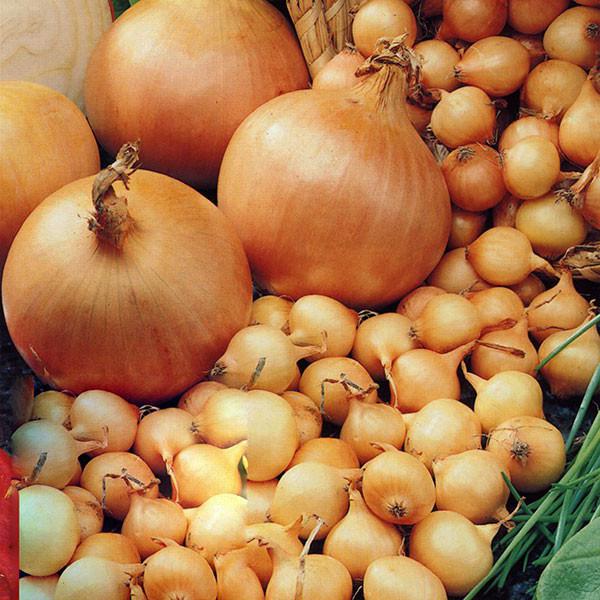
- 3 days before planting, the sets that were stored outside the house must be warmed up, which can be done near the radiator. For planting stock stored at room temperature, this process is optional. This is important, otherwise cold bulbs will give arrows.
- After warming up, the onions are soaked in a solution of any complex fertilizer at the rate of 1 tbsp. spoon for 10 liters of water. The procedure takes 10 hours.
- The last stage of preparation - you need to place for 10-15 minutes in a solution of 1 teaspoon for 10 liters of water copper sulfate whole onion sets. Planting is done after it has been thoroughly washed. This precaution against fungal diseases is carried out without fail, so as not to regret the lost harvest in the future.
Depending on the purpose of the onion set, the top is either cut off before planting, and then it will grow on a feather, or not, in which case it will yield onion harvest.
Onion set care
To get a good harvest, you need to follow the requirements of the onion sets. Caring for him is simple, but work should be carried out regularly:
- the soil should always be loose;
- weeding is carried out when the weeds are still small;
- watering of onion sets using the sprinkling method is carried out often, especially in May and June, during its intensive growth;
- after watering, the soil should be loosened.
Weed weeding is one of important points that cannot be ignored. It should not be allowed until the weed grows up, so that it is easier to destroy it. Large weeds can move the bulbs to the side, inhibiting their growth and affecting the entire crop.
These simple actions will give a high yield of seedlings, from which beautiful onions will turn out in the future.
Top dressing onion sets
If in the fall work was carried out to fertilize the soil with humus, then in the spring it only needs to be dug up. But if the timing shows that the growth of foliage is slower than it should, then it is better to feed the seedlings.
To do this, it is enough to dilute 1 tbsp. droppings in 10 liters of water with the addition of 1 tbsp. tablespoons of urea and water the garden at the rate of 3-4 liters of mixture per 1 m2.
Feeding can be done with the next watering.
Diseases and pests of onions
Unfortunately, onions can be attacked by pests such as tobacco thrips, onion fly, root mite, stem nematode. He is also in danger of diseases such as peronosporosis, gray rot that affects the neck of the onion, root rot and mosaic.
To avoid many problems, experienced gardeners recommend not using chemicals for fertilizers, but using only organic matter. The centuries-old experience of using organic fertilizers such as manure, compost, urea and poultry droppings shows that it is the plant's immunity that does not give rise to diseases.
Mineral fertilizers create an attractive environment for attracting pests to onion sets, as they change its metabolism. It is better to use nettle infusion as a growth biostimulant than to involve chemicals in the process of increasing yields.
Phosphate and potash fertilizers, used in the recommended doses, will increase the plant's resistance to pests and diseases, but nitrogen bait can harm them. It is necessary to introduce such drugs with extreme caution and only when there really is a need for it.
The disinfection of the onion sets before planting will save the crop and make it abundant.
Planting onion sets in autumn
Planting seedlings for the winter has become very popular due to the economic benefits that can be gained from harvesting early crops.
In order to plant winter onion sets, it is better to use varieties such as Carmen, Danilovsky, Strigunovsky local, Sturon or Myachkovsky-300.
To obtain the harvest of onions, the smallest seedlings are selected, furrows 4-5 cm deep are made in the ground, onions are placed and covered with earth. It is important not to cut off the necks of the onions, but to insulate the garden. 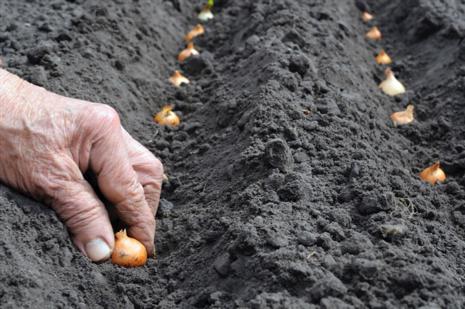
To get an early harvest of feather onions, on the contrary, the largest seed bulbs are selected and sown in frequent rows, after which they are sprinkled and also insulated for the winter.
syl.ru
Onion varieties for the Urals
Good day!
I want to tell you about the varieties of onions for the Urals. These varieties are included in the state register of the Russian Federation and are tested, tested specifically for our climatic and light zone. Because different regions receive different amounts of light and heat. The Ural region includes Kurgan, Chelyabinsk, Orenburg regions and Bashkiria. The description will indicate all regions for which these onions are suitable. In order not to list them every time, I will designate them with numbers, as in the registry:
- Northern- Murmansk, Arkhangelsk regions. Republic of Komi, Karelia.
- Northwestern- Kaliningrad, Vologda, Kostroma, Novgorod, Leningrad, Pskov, Yaroslavl, Tver regions.
- Central- Vladimirskaya, Bryanskaya, Kaluga, Ivanovskaya, Ryazan, Moscow, Tula, Smolensk regions.
- Volgo - Vyatsky- Kirov, Sverdlovsk, Nizhny Novgorod regions. Republics of Mari El, Chuvash, Udmurt, Perm Territories.
- Central Black Earth- Voronezh, Belgorod, Lipetsk, Kursk, Tambov, Oryol regions.
- North Caucasian- Krasnodar, Stavropol Territories, Rostov Region, Republic of Adygea, Karchayevo-Cherkesskaya, Kabardino-Balkarian.
- Srednevolzhsky- Samara, Penza, Ulyanovsk region... Republic of Mordovia, Tatarstan.
- Nizhnevolzhsky- Volgograd, Saratov, Astrakhan regions. Republic of Kalmykia.
- Ural- Orenburg, Kurgan, Chelyabinsk region, Republic of Bashkortostan.
- West Siberian- Altai Republic. Novosibirsk, Kemerovo, Omsk, Tyumen, Tomsk region, Altai Territory, Khanty-Mansi Autonomous Okrug.
- East Siberian region- Chitinskaya, Irkutsk region, Krasnoyarsk region. Republic of Sakha, Tuva, Buryatia, Khakassia.
- Far Eastern- Kamchatka, Amur, Sakhalin, Magadan regions. Khabarovsk, Primorsky Territory.
Onion varieties for the Urals with photos and descriptions
Arzamas
This is an old, well-known, time-tested folk selection for cultivation in a two-year culture, through sevok. The bulb is from elongated-rounded to cuboid-rounded. The sizes are average, weighing from 40 to 80 grams. The variety was zoned in the Gorky (now Nizhny Novgorod) region in 1943. The mid-ripening period is from 100 to 110 days. Medium-sized, small-sized. It is possible to grow up to a large bulb in one year. The color of the scales is dark yellow, even with a brown tint; inside the scales are white, juicy, dense. Matures before harvesting up to 96%. Stores well in winter.
Growing regions - 1, 2, 3, 4, 5, 7, 8, 9.
Variety "Arzamassky"
Bessonovsky local
An early multicellular spicy variety. Can be grown in annual and biennial crops. Round-flat bulb, dense, yellow scales outside, white inside. The bulbs grow to a weight of 36-55 grams. From germination of the first feathers on the set to their lodging, 60-80 days pass. Keeping quality is good, can be stored practically until spring - 8-9 months.
Suitable for regions - 4, 5, 7, 8, 9, 10, 11, 12.
Variety "Bessonovsky local"
Buran
Late-ripening variety. The bulb grows as a single-celled, three-celled bulb. Designed for cultivation in a two-year cycle. A versatile variety with a spicy flavor. The bulbs are dense, round, weighing 67-100 grams. Dry scales are bright yellow with anthocyanin, juicy - white. Productivity up to 12 tons per hectare. Before harvesting, ripening is about 63%, and after ripening - 89.2%. Stored well. May be ill with peresporosis. Yields stable with large, even bulbs, with good keeping quality, resistant to bacterial diseases.
I did not find this variety in the State Register for 2015. Apparently, it has already been excluded, but it continues to live as a local variety, spreading by local gardeners.
Zoned by Central, Middle Volga, Ural regions.
Variety "Buran"
Boterus
Medium early variety. Grown in one year from nigella and in a two-year culture. Large flat-rounded onion, weighing 60-80 grams. Outside, the scales are yellow, inside - white. Spicy taste. Before harvesting, the variety ripens by 85%, after ripening by 97%. Suitable for winter storage.
Growing regions - 3, 9, 10 .
Variety "Boterus"
Moldavian
A mid-season variety of the selection of the Pridnestrovian Research Institute of Agriculture for cultivation in one season. When sevkom is planted in the second year, it goes into the arrow. Ripens in 105-110 days. Flat-rounded or rounded onion, weighing from 70 to 130 grams, with good conditions up to 200 grams and more. Outside, the scales are pink-brown with a white-purple tint, and inside are pale purple. Two-four-pronged. Universal purpose, spicy taste. Average yield is 25-38 tons per hectare. During storage, the safety of onions is 90-95%.
Variety "Moldavsky"
Myachikovsky 300
An early variety from full shoots from seedlings to lodging of a feather takes only 80-90 days. Medium density, flat or onion, weighing up to 110 grams. The scales are yellow on top, and white on the inside. Small-sized variety, universal purpose, semi-sharp taste. Stores well in winter. Suitable for growing by seed for one year.
Variety "Myachikovsky 300"
The variety is suitable for growing both by seeds in one season and by sowing in two years. The bulbs are completely dark purple, both on top and on the inside. The period from the first green feathers to their lodging is 95 days. Rounded flat onion weighing up to 120 grams, semi-sharp taste. The yield is usually 1.5 kg / m. Onion scales are dense, strong, recommended for long-term storage.
Suitable for growing in regions - 3, 4, 5, 6, 9.
Variety "Red Baron"
Siberian Annual
Super early variety. When planting from seed, it ripens for 60-70 days! If grown from seeds, then for 90-100 days! A lot of greenery, a blue-green feather. Flat or flat-round onion, yellow in color. Semi-sharp taste. The weight of a bulb grown from seed sets reaches 200 grams, from seeds with an annual culture up to 100 grams. The Siberian One-year-old variety is well stored and resistant to shooting.
Suitable for growing by region – 4, 9, 10 .
Variety "Siberian One-Year"
Strigunovsky local
An early spicy variety. Suitable for cultivation for a year and a two-year period from seedlings. Dense bulb, rounded, four-pronged, weighing 45-80 g. Outside, the scales are yellow with a grayish or pink tint, white inside. The variety is valued for its good preservation in winter. Through sowing, the variety ripens for 80-90 days, from seeds when sown in early spring or before winter - for 110-130 days.
Suitable for growing in all regions of the Russian Federation.
Variety "Strigunovsky local"
Black Prince
Mid-season variety (100-105 days), created by VNIISSOK. Suitable for sowing before winter and early spring (annual) and growing through onion sets (biennial). Rounded, dense bulbs, weighing 60-100 g. The purpose is universal. The scales are dark purple. Two-three-pronged, small-breasted variety, semi-sharp taste. Productivity up to 50 tons / ha. Keeping quality is good.
Variety "Black Prince"
Exibition
Medium late grade. A very productive, cold-resistant variety intended for obtaining full-fledged onion heads in annual crops. It is prized for its high yields in various climatic conditions. During the summer, beautiful, dense oval bulbs ripen up to 800 g. The upper scales are straw-colored, white inside. Surprisingly juicy, sweet variety. It is resistant to disease.
Suitable for growing in all regions of the Russian Federation.
Variety "Exibishen"
Timiryazevsky
An old variety, which is no longer in the state register, but it lives in vegetable gardens. Zoned in 1968. Early ripening, small-celled, little germinal. Designed for growing from seedlings in a biennial culture. Flat-rounded onion, dense, spicy taste, weighing 50-70 grams. Outside, the scales are light brown, sometimes yellow, inside are white. Maturation depends on the weather from 65% to 100%. Keeping quality is good up to 95%.
Suitable for growing in non-black earth regions: Ural, East and West Siberian, Volgo-Vyatka.
Variety "Timiryazevsky"
These are all the varieties that I found in the State Register for growing in the Urals. There are more hybrids there, but I do not plant them myself and will not recommend them to my readers.
The best varieties of onions "not for the Urals"
There are also popular varieties that, despite the registers and recommendations of academicians, the gardeners of the Urals grow on their plots. They spread on their own due to their popularity.
Danilovsky 301
Agrofirma Aelita and VNIISSOK. Mid-ripening variety, small-sized, low-germinated. It takes 90-100 days from the mass appearance of green leaves at the seedlings to lodging. The bulb is flat-round and flat, weighing from 80 to 160 grams, with a spicy taste. Outside, the scales are dark red with a purple tint or purple, and inside are light purple. The yield of varieties from seedlings is from 12 to 33 tons / ha.
Variety "Danilovsky 301"
Karatalsky
Selection of the Kazakh Research Institute of Agriculture. An early variety, ripens in 109 days. Recommended for growing as an annual. The bulb is usually round, sometimes flat, dense, weighing 120 grams. Small bow. The yield is on average 4.4 kg per m. Outside, the scales are golden yellow, and inside they are white. The variety has a pleasant semi-sharp taste, intended for fresh consumption and for processing. His keeping quality is satisfactory - on the C grade. Stable, productive variety with large, good quality bulbs . The onion is designed to be grown in one year from seed.
Variety "Karatalsky"
She did not exclude it, since it became widespread not only in the recommended regions, but also in the Urals. With early sowing under a temporary shelter, it gives good yields in the Ural region. The variety is mainly salad, with a pleasant semi-sharp taste. In the second year, it should not be planted with sevka, it will go to the arrow.
Carmen MC
The variety is medium late, from the emergence of mass shoots from seeds to lodging of feathers, 120-140 days pass. Designed to obtain a harvest in one season from seeds in open ground or seedlings. The bulbs are round-flat, leveled, weighing from 90 to 100 grams. Dry scales are purple, juicy - white with a purple tint. Refers to salad onions - semi-sharp taste, almost sweet. Very large bulbs can be obtained when grown through seedlings. Average yield 3-4 kg / m. The variety ripens perfectly, is suitable for storage, but its main purpose is fresh and for processing.
Growing regions - 3, 5, 7, 8 .
Variety "Carmen MS"
Rostov local
An early local old variety, bred in the Yaroslavl region. Best bow for northern regions of Russia. Grown from sevka in a biennial culture. A sharp early ripening variety - ripens 73-93 days after the first green feather. Flat-rounded onion, golden yellow, weighing 30-60 grams. Stored all year round, until the next harvest.
Variety "Rostov local"
Odinovets
Mid-season variety (105-120 days). Small-celled, three-pronged. Suitable for annual and biennial cultivation. Flat and flat-round bulbs, dense, weighing 60-80 grams, semi-sharp taste. The upper scales are golden yellow, white inside. It is good fresh and for storage, it is distinguished by good keeping quality. Universal purpose. Valuable for the safety of turnip and onion sets in winter without loss of quality. Suitable for forcing on feathers.
Variety "Odinovets"
Chalcedony
Medium late variety (up to 114 days). The bulb is rounded, with a pungent taste, with dry, bronze-colored scales. It ripens very well and is stored all winter. Both turnip and sevok. The appointment is universal.
Growing regions - 6, 8.
Variety "Chalcedony"
Stuttgarter Riesen
German early spicy variety, for a two-year growing period. The appointment is universal. The bulb is flat, dense, weighing 50-90 grams. Outside, the scales are golden brown, white inside. Ripening of the variety by the beginning of harvest is 55%, after ripening 96%. Stores well. Productivity from 10 to 35 tons / ha. The variety is susceptible to cervical rot diseases, and can also be severely affected by downy mildew.
Growing regions - 3, 4, 7, 11.
Variety "Stuttgarter Riesen"
This variety is surprisingly popular. Five years ago, we simply could not find another on the market. Apparently, its popularity is based on its early maturity. But he gives good harvests only on rich, very fertile land and in favorable conditions. If it rains all summer (and we have such weather, despite the hot years and general warming), then you can lose the entire crop, it will simply rot and will not be stored, even after drying.
Ten years ago, only this variety grew in me and I was left without onions for the winter. It rained all July and had to clean up in such weather. As I did not dry it later, it still rotted. Therefore, the choice of a variety must be approached responsibly, our harvest depends on it.
These are the varieties of onions for the Urals and other regions that turned out today in the article.
belochka77.ru
onion varieties
Aleksandr Karnaukh
LEEK
#Karatan early ripening
#Bulgarian late ripening
BOW-BATUN
#Maysky 7
# Salad 35
# Gribovsky 21
SOUL ONION
SCHNITT BOW (PERENNIAL)
ONION - SLIDER (IRON)
SHALLOT
Other names: charlotte, shrike.
Nicolae
naiti or recognize or want kushati
Maria
Onion - set
RED BARON
An early ripe two-three-pronged variety. Forms round-flat, dense bulbs weighing 50-70 g. The bulb has a dark red color. Contains a lot of dry matter, sugars and vitamin C. Onions are distinguished by 100% ripeness and good keeping quality (7 months). Prefers sandy loam, fertile soils.
Used for fresh consumption, home cooking and canning. Low-flavored bulbs are especially good in salads and fresh vegetables.
Onion - set
SETTON
A new mid-season high-yielding variety with rounded large bulbs, weighing 150-175 g, spicy taste and yellow-brown color. Derived from the Sturon variety, that is, Setton is an improved Sturon. Stores very well (7 months). It has very uniform quality bulbs, suitable for professional cultivation. Highly resistant to shooting. Prefers sandy, fertile soils.
The distance between plants in a row is 8 - 10 cm, row spacing is 20 - 25 cm.
___________________________________
Onion - set
STURON
Medium early variety, very popular in Europe, with rounded large bulbs weighing 150-180 g, spicy taste and yellow-brown color. Stores very well (8 months). This variety is intended for cultivation north of 38 degrees latitude. It has very uniform quality bulbs, suitable for professional cultivation. Differs in high productivity.
___________________________________
Onion - set
SNOWBALL (SNOWSTAR)
Medium late amateur variety, with rounded large bulbs, weighing 145-160 g, sweet taste and white color. Salad bulbs, very tasty. The bulbs can be stored until mid-winter (6 months). Sowing varieties with white bulbs must be stored warm (t 20 degrees), otherwise bulbs may be shot.
Prefers sandy loam, fertile soils. The distance between plants in a row is 8 - 10 cm, row spacing is 20 - 25 cm.
___________________________________
Onion - set
TURBO
Medium early ripening variety, with rather round bulbs weighing 80 g, attractive brown color, with a firm skin. The dry matter content is quite high - about 15%. It can be stored for 6-8 months under proper conditions. Prefers sandy loam, fertile soils.
___________________________________
Onion - set
CENTURION F1
An early ripening hybrid, gives a stable harvest. Forms medium-sized bulbs weighing 65-80 g.
Prefers sandy loam, fertile soils. The hybrid is resistant to shooting and a combination of early maturity and keeping quality - very well stored (8 months).
___________________________________
Onion - set
SHETANA MC
Medium early grade. The period from regrowth of seedlings to lodging of leaves is 65 - 85 days. The bulb is round, dense, weighing 50 - 80 g, the color of dry scales is straw-yellow, the juicy scales are white. The taste is semi-sharp.
Prefers sandy, fertile soils. The variety is distinguished by resistance to fusarium, as well as stable yield, uniformity of bulbs, their high ripeness and excellent keeping quality (6 months).
___________________________________
Onion - set
STUTTGARTER RISEN
Early maturing, popular, high-yielding, single-primordial variety, from growing of seedlings to harvesting in 66-73 days. Forms large, flat-rounded bulbs weighing 150-180 g, yellow-brown color, pungent taste. The variety is resistant to shooting and downy mildew. Universal use, good storage (6 months).
Muscle
LEEK
Also called pearl leek. A biennial plant, in the first year green leaves and a thickened false stem or white leg (the main edible part), 15-30 cm long and 5-7 cm thick are formed. -lilac flowers.
Karatan early ripening
Bulgarian late ripening
BOW-BATUN
Other names: Tatar, fist, winter, sandy. Winters well, grows quickly in early spring and retains tender for a long time. succulent leaves, cutting the leaves stimulates the branching of plants.
Maisky 7
Salad 35
Gribovsky 21
SOUL ONION
A perennial plant with a small false bulb and flat narrow leaves, use delicate leaves that have a slightly garlic taste, grow back in early spring and grow until autumn without turning yellow.
SCHNITT BOW (PERENNIAL)
Other names: chisel, Siberian, skoroda, tribulka. High frost resistance, in early spring it releases leaves hollow inside, which are very tender, do not coarse for a long time, intended for cutting, the leaves are rich in vitamins (much more than in onions), grows quickly after cutting, can be planted fruit trees(to scare away insects).
ONION - SLIDER (IRON)
Differs in early regrowth of green feathers, leaves are flat, 2-3 cm wide and up to 40 cm in height, winter-hardy, leaves taste pleasant, weak pungency, refers to salad onions, contains a lot of iron.
SHALLOT
Other names: charlotte, shrike. Vegetatively propagated form of onions, multi-lobed, the bulb is divided into several small bulbs attached to a common bottom and covered with a common shell (like garlic), the bulbs are well preserved, planted in the ground, a green feather is expelled for 15-20 days, the leaves are flattened, with a waxy bloom, very delicate taste, the bulbs are small, but tasty.
How to choose onion sets? What is the best onion variety?
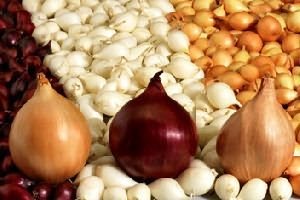
GK
I like to plant the following varieties: Chalcedony (large, tasty, stored for a long time),
Gold (beautiful, medium in size, stored for a long time);
Sturgarten Riesen (large, well stored),
Carmen (red, stored, sweetish in taste, grows very large),
Bessonovsky (medium in size, well stored).
Every year I plant several of these varieties. Some varieties can be planted in March for seedlings, so as not to buy an expensive senchik. Onion seedlings take root very well in the garden, almost! 00%. If there are no seedlings, it is better to buy a senchik in a specialized store, it should be strong, without voids, not wet, but not dry either.
natla
When choosing onion sets for planting, you need to watch that the bulbs are strong and medium in size. A large onion does not guarantee you a good harvest; it will most likely be good for feathering. But if you want to grow onions for storage in the winter, then it is best to give preference to medium-sized bulbs.
In my experience, any of the onion sets can produce an excellent harvest. The main thing is proper care and agricultural technology, the quality of the land. The same variety on different soils and with different watering gives a different yield.
As for the varieties, the "Stuttgarter Riesen" is a good variety. It is also good in that you can grow onions from it directly from seeds in one year, however, it will not be as large as from onion sets. Yet good varieties: Dayton, Exibition, Sturon, Setton F1.
dolfanica
Sevok should be grown only on weed-free soils and on fertile soils.
Onions can be spicy, semi-spicy and sweet, so sets are grown from spicy varieties of onions.
There are small-breeding sevka varieties, the best sevka bulbs of this type should be 0.7 - 1.4 cm in diameter.
The best bulbs in multi-nest varieties should be 1.4 to 2.2 cm in diameter.
Sevka bulbs up to one cm are stored at a temperature of 1 to 5 degrees.
But bulbs with a diameter of up to 0.8 cm can be planted before winter if a good amount of snow falls in winter.
The disadvantage of the Stuttgarter Riesen variety is that cervical rot is susceptible to disease.
But the Centurion variety is well stored, but the Hercules variety is stored even better.
jarptica
Onions are sharp and semi-sharp, early ripening and medium late.
Mid-season includes:
- Odintsovets (peninsular);
- Stuttgarter Riesen;
- Danilovsky (peninsular);
- Strigunovsky (sharp);
- Arzamassky;
- Bessonovsky;
- Rostov onion (spicy).
Mid-late varieties:
- Silver Prince (peninsular);
- Exibition (sweet).
They are all very productive.
Choose large bulbs at least 1.5 cm in diameter. Dry them well before planting.
eLearner
About two weeks before planting, the onion sets must be warmed up at a temperature of about 40 degrees Celsius for eight hours. As a result of this procedure, the disease resistance of your planting material will increase.
3-4 weeks after planting, the first prophylaxis against peronosporosis can be carried out. For this, the beds are treated with 1% Bordeaux mixture.
Elden
It all depends on your taste, which one will you prefer? Red or white, maybe yellow, sweet or bitter, small or huge?
But in any case, I advise you not to dwell on one variety and plant 3-4 varieties of onions in different beds ...
Here I can offer you a choice of some varieties:
Round, but flat and dense bulbs, somewhere between 50-70 grams. Dark red color.
Sturon
Large and round bulb, about 150-180 grams. Yellow-brown color.
Snowball (Snowstar)
Large and round bulb, about 145-160 grams. White paint
Turbo
Round onion, about 80 grams. Brown color.
Centurion F1
Medium onion, about 65-80 grams.
Stuttgarter rizen
Large, flat-rounded onion, about 150-180 grams. Yellow-brown color
krusu
Probably for each region there are some sort of onion. I live in Siberia, experimented with different varieties and in the end settled on one - this is Stuttgarter Riesen. His bulbs turn out to be large and, most importantly, the keeping quality is very good (we have very long winters, so this is an important factor). Well, how to choose a set? Take medium onions, in your photo they are located below.
elena-kh
This year I have planted the following 3 varieties of onion sets.
- Carmen (this is a great red onion, slightly sweet taste, I recommend).
- Stuttgarter Riesen (in my opinion, the most common onion, but a very productive variety, plus large bulbs grow).
- Jumbo (this is a mid-season white onion).
Everything is growing in the northern part of central Russia, I don’t know about the rest of the regions.
Lorelei
Before planting a variety, it is better to try the ripe bulbs and decide which one you like.
Praised by Sturon (medium early, large), Hercules, Semko golden, Centurion (juicy, peninsular), Red Baron, Bamberger.
Stuttgarten Riesen is perhaps the most famous variety, good keeping quality, although someone does not like flat heads and harsh taste.
Alex Zaycekrad
There is no best type of onion. The choice of a variety is a matter of taste. I prefer spicy varieties, for example Strigunovsky, Golden.
When choosing a variety of onions, you should pay attention to the composition of the earth that is comfortable for it. Then the landing will be most effective.
iren
we have black soil, and onions love light sandy soils, so I choose only red - it grows well and is normal taste, but any the other is shallow and bitter.
Varieties of onion sets differ in bulb size, planting time, resistance to environmental conditions and taste, so you need to be able to choose the right variety that is suitable for planting in a given area.
≡ Contents

At the same time, it makes no sense to choose the type of onion that you do not like for its taste. And we must not forget that different varieties are suitable for autumn and spring planting. For the reasons listed, choosing the right variety must be wisely and carefully so as not to waste money.
Winter varieties of onion sets
Winter onion varieties are those that are preferably planted in the fall so that they overwinter in the soil and begin to develop in early spring. Moreover, it is not recommended to plant varieties for spring cultivation as winter crops: they shoot more actively and do not tolerate frosts well, and in a harsh winter, a bed of them will not survive until spring. Therefore, when buying, you must initially choose exactly the onion that is intended for growing winter crops, and for planting in the spring, take a separate variety.
The best and most convenient varieties of onion sets for winter planting- these are the ones that were bred in Holland. Dutch varieties are some of the most resistant and productive varieties. Here are examples of such varieties: "Shakespeare", "Troy", "Radar". But they do not exhaust the entire list of types of onions for winter sowing... And an inexperienced gardener should read the advice of more experienced colleagues in order to know which variety to choose. Some of the varieties will be described below. winter onions popular with site owners.Onion variety "Shakespeare"
This semi-sharp variety has a number of useful properties that make it one of the best varieties for winter planting.
It has the most frost-resistant bulbs, making it ideal for growing in central Russia. Shakespeare has dense and strong surface scales, which allows the seed to transfer frosts down to -18 ° C. For the same reason, it is stored for a long time, retaining all its taste. If a gardener is looking for varieties of onion sets for the Moscow region and other regions with the same climate, then Shakespeare will suit him to the fullest.
For inexperienced gardeners, this onion is also recommended because of its resistance to various diseases and pests. But it should be remembered that it is intended specifically for winter cultivation. If you plant it in the spring, then there will be no big harvest.
It is not difficult to recognize the bulbs by their appearance. This vegetable has a dense, smooth and shiny rind of golden red color. The pulp is white, dense. The weight of an individual bulb reaches 100 g, which is a lot. At the same time, the variety is distinguished by its yield, for which the owners of the plots also appreciate it. Ripening time - 2.5 months, although the period may vary depending on climatic conditions.
Onion variety "Troy"
Like the previous variety, this is a Dutch onion, and they are similar in their characteristics and description.
Troy is a relatively new species, but it is a very successful and easy-to-grow hybrid. It is worth remembering that he, like all hybrids, is not suitable for breeding: the bulbs of the second generation never adopt the qualities that distinguish the first. It is not suitable for breeding for greens.
it onion, which, despite its average size, is distinguished by its yield. From 1 sq. m of the garden, you can get 5 or more kilograms of vegetables.
Although this variety is not spicy, it can be stored for a long time. The shelf life, at which the bulbs do not deteriorate and do not lose their taste, is 115-125 days. Ripens early. In the middle lane, the crop is harvested in July or early August. It is not prone to shooting, which is why both planting material and ripe bulbs are stored for a long time. The rhizomes have a rounded shape with dense golden scales. The pulp is white, dense.
This variety is suitable both for pickling and for use in salads. Another advantage of this variety, for which experienced gardeners appreciate it so much, is its resistance to diseases and pests. He is not completely protected from them, but he does not get sick often, which has a positive effect on the harvest.
Onion variety "Radar"
Another Dutch variety for winter sowing, which is loved by many gardeners.
A distinctive feature of the Radar is the size of its bulbs. The average weight of one fruit is 150-200 g, although it can reach a weight of 0.5 kg. The pulp is very firm, white, semi-sharp, with a pleasant taste. The shape of the bulbs resembles a somewhat flattened ball. The scales are dense and strong, of a golden hue.
This variety easily withstands even severe frosts. It will lie perfectly in the soil all winter, and then it will give an early harvest.
This type of onion is very resistant to diseases. Although pests such as onion fly and stem nematode are still dangerous to Radar.
According to many gardeners, this variety begins to bear fruit as early as May, subject to correct sowing. This is an added benefit that is also worth appreciating. Indeed, at this time, all the pests have not yet had time to wake up, and nothing threatens the early harvest of onions. Moreover, early fruiting is possible not only in the southern regions, but also in the conditions of central Russia. However, this variety is not suitable for growing on greens.
Onion variety "Ellan"
This variety was bred by domestic breeders and is one of the best for growing in central Russia. Although this variety appeared relatively recently, it has been bred for a long time. The aim was to obtain a frost-resistant winter onion that will ripen early and yield a good harvest. This variety is recommended to be sown either in autumn or at the very beginning of spring. For 1 sq. m planted a maximum of 0.2 kg of seed.
Ellan is an ultra-early variety: the harvest ripens in June, and in warm regions - even at the end of May. Unfortunately, its keeping quality is low, but it allows you to get bulbs for salads and pickling even 1.5-2 months before harvesting spring varieties.
In addition to yield, Ellan has a number of additional benefits. It is sweet and delicious. It is also resistant to disease, which also makes growing easier.
The appearance of this variety does not stand out too much. It has straw-yellow bulbs, rounded, slightly flattened. Their average weight is 110 g, although sometimes Ellan grows to 0.5 kg. Not suitable for growing on a feather.
Senshui Yellow onion variety
This variety was bred recently, but it has already been appreciated by gardeners.
This variety was bred in Japan, but at the same time it perfectly adapts to the conditions of the middle zone in Russia or Belarus. It is suitable not only for obtaining a turnip, but also for growing on a feather. For the winter variety, it has a good yield, as well as a pleasant taste and excellent keeping quality. Its bulbs can be stored for up to six months without losing their presentation and taste. Like most winter varieties, it ripens early, already in June or early July.
The Senshui Yellow variety is resistant not only to frost, but also to fungal diseases. In particular, according to experienced site owners, this variety rarely suffers from downy mildew.
As the name implies, its bulbs have yellow scales. It has a high density, which ensures long-term storage. The shape of the bulbs is round or somewhat elongated, the set always resembles a spindle. Good seed has the same shape and size. Choosing onions for sowing should be very careful, often other similar varieties are issued for the Senshui.
Early ripening onion sets
There are many varieties of onions that are preferable to plant at the very beginning of spring. Among them there are varieties that are universal in terms of characteristics, those that can be grown as winter crops. An example of such a bow is the Stuttgarter Riesen. But among the names of varieties of early onion sets, you can find other good varieties. The best varieties onion sets for early planting:
- Texas yellow;
- Centurion;
- Snowball;
- Golden Semko;
- Corrado;
- Siberia.
The varieties of early ripening include mid-early species. You should be aware that most of the early varieties are sharp and semi-sharp. But sweet among them are few, with the exception of white onions. Among these varieties there are both new and well-known species.
Early varieties are rarely grown for winter storage, more often the crop is used throughout the year. When choosing such a variety, one should pay attention not only to its taste, but also to its resistance to weather conditions and diseases. Inexperienced site owners should pay attention to the following varieties of onions for early planting.
Snowball variety
Translated from English, snowball means "snowball", which is not surprising, because this variety has white scales and is just as white inside the bulb. It is not easy to confuse it with other varieties, since the appearance of this variety is very unusual.
Snowball is prized not only for its unusual color. Its advantage is not a white onion, but a pleasant and mild taste. Snowball is most commonly used in salads.
But its resistance to weather conditions and diseases is not the highest. For cultivation in the north and north-west of Russia, for example, it is not very suitable. Unfortunately, this variety is often affected by fungi, in particular, peronosporosis, therefore it is recommended to pre-treat the garden with fungicides to prevent diseases.
But on the other hand, it has excellent keeping quality - the harvest is stored for a long time, and without loss of taste.
Snowball is also used for winter storage. Its bulbs are large, elongated, with smooth and dense scales. The yield is high: from 1 sq. m is collected 5.5-6 kg. The sevok is the same color as the ripe rhizomes, the onions are pure white, so it is not too difficult to identify it when buying.
Corrado variety
This mid-early variety appeared on sale quite recently and has already been liked by many gardeners. Its taste is spicy, so it is not very suitable for salads. But the variety has excellent keeping quality. Its bulbs are well stored without losing any presentation or taste. Its peel is golden in color with a slight reddish tint. The Corrado is sometimes confused with the Cupido variety, but the second variety is straw yellow and does not keep well.
Corrado ripens quickly enough, within 3 months. The mass of the bulbs is on average 125-130 g, although larger fruits are also found.
This variety is characterized by a high yield: it is quite possible to collect 6-7 kg from 1 sq. m beds. The secret is that from all planted sets usually at least 95% of the bulbs ripen. And with proper care, it is possible to achieve 100% germination.
Another advantage of the seed of this variety is that it is well stored, which is the reason for its excellent germination.
Stuttgarter Riesen variety
Although officially this variety is considered mid-season, in terms of planting time, Stuttgarter Riesen is universal. It can be planted before winter, and in early spring, and more late date... And in any case, it sprouts well, ripens on time and gives a rich harvest. You can plant both on a turnip and on a feather. For growing greens, bulbs are usually used that have been rejected for planting on a turnip.
The taste of this onion is semi-sharp, but at the same time it is perfectly stored. Among its advantages is decent resistance to various diseases and pests. This is another reason why the variety is so prized by many site owners.
The Stuttgarter Riesen was bred in Germany, but is also great for local growing conditions. It has large bulbs weighing from 100 to 250 g. They have a rounded, somewhat flattened shape and golden yellow scales. But their shade can vary in each case. But the color of the sevka is more uniform. It can be neither straw shade nor dark brown. Only golden yellow color. The scales are dense and durable, and the bulbs themselves contain a small amount of moisture, which is why they are reluctant to deteriorate and rot, and are also stored for a long time. This applies to both adult fruits and young rizen sets.
Variety Golden Semko
This variety is more often used for breeding through seeds, but it can also be grown through planting seedlings. With the second method, the bulbs ripen faster and produce a higher yield. By the way, this variety is characterized by a decent yield, 1 sq. m of the garden brings 4-5 kg of bulbs. One of the advantages of this variety is its adaptability to conditions. the environment... It can be grown in the southern regions, and in the middle lane, and in the north of Russia. But planting and ripening times will vary slightly depending on the region. But the quality of the crop will be the same. For this variety, it depends solely on care.
But resistance to weather conditions is not the only advantage of the variety. Golden Semko is also loved for its resistance to fungal and viral diseases of onions. It ripens in 2.5-3 months and is stored for a long time. On average, its bulbs retain their properties and do not deteriorate for six months. All of them are round in shape, with an average weight of 85-90 g, although larger fruits are by no means a rarity. Their scales are yellow, golden in color, dense and smooth. This variety has a semi-sharp taste, so it is easier to handle and more versatile. Golden Semko is good for both curls and salads.
Siberia variety
This variety is used both for early spring planting and for growing winter crops. Despite its name, it was not bred in Russia, but in Holland, and is intended for cultivation in the southern regions. This is a hybrid, which must be acquired only by the first generation, since only it possesses the properties necessary for the gardener.
The Siberia variety is intended for cultivation on the territory of Ukraine and in the southern regions of Russia. For growth in the middle lane, this variety is poorly adapted. Siberia is grown for a turnip; it is unsuitable for obtaining greens.
This type of onion is relatively hardy. Its other pleasant characteristic is yield, as well as early maturity. In the south, with winter plantings, the variety is harvested in May and in the first half of June. Even with a later spring planting, the seedlings have time to fully ripen by the first half of July.
The bulbs are large and juicy, 150-200 g each. They have a classic rounded shape with golden scales. Semi-pungent taste without pronounced bitterness, due to which Siberia is used both in salads and in canning. Due to all the advantages available, this variety is attractive both for owners of large farms and for ordinary gardeners.
Mid-season and late varieties of onion sets
Winter crops and early varieties make it possible to harvest onions when winter stocks run out. But these reserves allow the mid-season and late varieties of this culture. There are advantages and disadvantages to growing such varieties, and they are all worth knowing about. In particular, the period of active growth of the beds falls on the summer, when all pests are activated, so the site must be treated with insect repellents.
Also, do not forget about the fight against fungi and pathogenic bacteria: they are able to reduce the yield of those varieties by 30-50%, which ripen only by the end of summer and the beginning of autumn. Here is the opinion of many gardeners about the choice of onion varieties:
“Some summer residents argue which variety of onion sets is best suited for growing on the site: early, late or mid-season. And it should be understood that the early varieties are more resistant to shooting, and the later ones are the sweetest, therefore, if possible, it is worth planting both early and late varieties. Several varieties with different properties, shelf life and flavor characteristics can satisfy anyone, so you shouldn't dwell on one thing. "
The mid-season and late varieties include many tasty and productive varieties, which owners of personal plots are so fond of. These varieties include the Red Baron, family onions, Sturon, Exibishen. Some of these varieties can be planted in early spring, while others are only suitable for late planting. It is not recommended to grow them as winter crops.
Sub-winter planting is allowed only in southern regions with a mild climate and warm winters. Below are examples of mid-season varieties that will appeal to a gardener who does not have much experience.
Variety Red Baron
The Red Baron, or Red Baron, is a variety that the owners of summer cottages have long fallen in love with. This is one of those varieties with which breeders have not yet decided how to classify it: as early or as mid-season. The thing is that the Red Baron plants beautifully both in early spring and in May. And in fact, and in another case, it gives a good harvest of tasty and healthy bulbs. By the way, it is called red for a reason: its scales and pulp have a rich red-purple color. It was for this unusual color that he got his name.
But the Red Baron is good not only because of its color. It has a pleasant, piquant taste and a very decent keeping quality. But the yield is not the highest: from 1 sq. m of the garden, it is possible to collect 3-3.5 kg of bulbs. They ripen within 80-96 days, depending on climatic conditions and care.
This variety is also known for its versatility: it can be planted almost at any time. It is not suitable for winter planting only.
Like most of the varieties presented, it is preferable to grow it through a set. Then the yield can be expected to be higher and the bulb size is larger. It is very easy to recognize the set of this variety: it has the same rich red-purple hue as ripe onions.
Family onions or shallots
If there is a universal variety, it is the beloved "family", a fruitful, disease-resistant and tasty onion. Shallot is its name in Europe, in Russia it is called family. You can grow it through seeds, but it would be much better to purchase or grow a set, and grow a "family" already through it.
This type of bulb has an elongated shape, they are well stored and used both in salads and for pickling. From this variety, you can get not only a turnip, but also a green feather. You can also grow it at any time of the year: it is suitable not only for late planting, but also for planting in early spring. When this variety is planted in May, with proper care and watering, it gives the highest yield.
The "family" has a sevok of a characteristic oval shape (inexperienced gardeners should look at his photo to remember exactly how he looks). When using seedlings in the southern regions, some gardeners manage to get 2 crops per year. This is the advantage over planting seeds, since it does not give such results. It is not difficult to buy a family set, it is often sold and is inexpensive.
Sturon variety
This variety is classified by some as medium early, which is not entirely true. Its ripening time stretches from 3.5 to 4 months, which characterizes it as a mid-season or even late variety. The seed is produced in Holland. This is a hybrid, and it is not suitable for independent breeding. But the purchase of sevka always justifies itself: this variety has many properties that are most useful for the gardener. For them, this variety is so loved by many gardeners.
Sturon does not have versatility in use due to its high pungency. But the same sharpness allows you to keep the harvested crop for a long time. The average shelf life of Sturon without loss of presentation and taste is 8 months.
This variety has large, elongated bulbs with golden yellow scales typical for many types of onions. Bulb weight is large and reaches an average of 190-200 g. Individual rhizomes weigh 0.3-0.4 kg. With an overall high yield, such indicators are certainly encouraging.
Such characteristics as unpretentiousness and high germination rate are also pleasant here. They allow you to get a large amount of onions even from a small garden. Well, in large farms, at least 32-33 tons of crops are harvested from 1 hectare.
Exibition grade
Another unusual guest from Holland, this hybrid is loved by many gardeners for its unusual appearance and pleasant taste. This variety is intended for late planting: it is planted not earlier than the second half of April, when the soil is completely warmed up and warm weather is established. If at night low temperature, then the landing is postponed to May.
Some gardeners believe that it is better to grow Exibishen from seeds, and not seed. But such plantings can never reach their maximum size, so it is still advisable to plant a set either purchased or obtained independently. And it should also be understood that, like all hybrids, this variety cannot be bred independently. One should always buy first generation seeds or sets grown by experienced breeders.
The appearance of this variety is extremely memorable, and its fully ripe bulbs cannot be confused with any other variety. Their color does not stand out in anything special: the classic straw-yellow color, characteristic of most of these varieties. But the dimensions are amazing. The mass of one ripe onion ranges from 0.4 to 1 kg, and this variety is simply unique in this parameter. The high yield of Exhibiting is ensured not by the number of ripe heads, but by their mass.
This onion also has a pleasant sweetish taste. The content of essential oils in it is low, which is why the typical onion bitterness is practically absent. Many hobbyists consume it raw, like apples or pears. This variety is perfect for preparing salads. Unfortunately, it has one drawback: it is not stored for a long time. The deadline without loss of taste is three months.
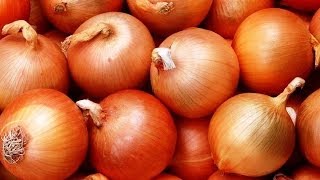
Varieties of onion sets. GuberniaTV
Honestly, it's hard for me to understand how you can not love
There are many varieties of onion sets, and among them there are really many good options... You need to choose the one that suits the needs of the gardener. And with proper planting, it will always be possible to harvest a good harvest, and such a harvest will certainly delight the owner of the site.
GROWING ONION
|
Onion - the most common type of onion. It has gained wide popularity due to the high taste of the bulb and tubular leaves (feathers), as well as its high yield and the possibility of long-term storage. In Russia, dozens of spicy, semi-sharp and sweet varieties of onions are cultivated everywhere. If desired and skillful, onions can be grown all year round, in winter - at home on a windowsill, in summer - in a garden. If the soil has not been prepared since autumn, it is prepared in spring - dug to the depth at least 25 cm. The root system of onions is weak, therefore it is necessary to provide it with the necessary nutrients in an accessible form. For this, it is desirable that organic fertilizers, especially manure, were introduced under the previous crop. Directly under the bow fresh manure do not apply even in autumn, as this causes rapid growth of leaves, but delays the formation and ripening of the bulb, worsens their rigidity. Mineral fertilizers are applied in moderate doses, and not all at once, but in parts - for digging and as top dressing during the growing season. Better to bring complex fertilizers: "Onion and Garlic", "Universal Kemir", nitroammofosk. You need to know that at the beginning of onion growth, nitrogen and potassium are especially needed, from the beginning of the formation of the bulb - potassium and phosphorus, which accelerate ripening and improve rigidity. Onion sets are planted in the ground when the soil warms up to +10 degrees to the depth of the bulb. In our area, this time is closer to mid-May . Plant the seed so that it is in a moist soil layer to a depth of 3-6 cm, depending on the size of the seed. Row spacing 20-25 cm, in a row the distance between plants should be 10-12 cm. |
How to prepare onion sets for planting |
Growing turnip onions from onion sets is the most common and reliable method, and no matter what planting material you use, it needs to be prepared for planting. Onion sets can be infected with thrips, onion mites, nematodes. From diseases - peresporosis (downy mildew) of cervical and white rot. There are several ways to prepare onion sets for planting ... You can choose the most acceptable one -. Onion sets in a mesh or gauze bag are placed in water at 45 degrees for 15 minutes. It is very important that the temperature does not drop below 45 degrees for 15 minutes. To do this, you need to add hot water, and measure the water temperature with a thermometer. Heating the onion sets helps to awaken dormant buds, reduces the possibility of shooting. Moreover, it is good way pest and disease control. After warming up, you can soak the onion in a weak solution of potassium permanganate for 12 hours. The method of processing onion sets in a solution of phytosporin is effective, and for scaring off onion flies in a solution of "Sochva" - liquid smoke. , how many and which varieties should be grown in a small area so that the harvest will last until spring? First of all, you need to choose the varieties that are most suitable for our area. For the normal development of the onion, the length of the day is very important, or rather, the ratio of the light and dark period of the day. Chilli onions are plants with a pronounced photoperiodicity, that is, the length of the day determines for it the timing of the beginning of the formation and ripening of bulbs. Onions are considered a long-day plant, an increase in the length of the day accelerates its development and formation of the bulb The minimum day length required for bulb formation is 13-14 hours for most varieties. When the southern varieties are grown in our region, the plants end their growth earlier, since the long day inhibits the development of leaves and stimulates the earlier formation of bulbs. As a result, early ripened bulbs are obtained, but small, and the yield is therefore significantly reduced. Such onions are also poorly stored. Therefore, it is better to buy planting material of onion sets in specialized stores. There are cases when unscrupulous sellers allegedly offer onion sets, but in fact it is a small, non-standard food onion with a diameter of 25-40mm. Outwardly, the bulbs look attractive - even, shiny, but a large onion from such a set will not grow. You can use it for growing greens, but nothing more. Agronomist-consultant of the company "Orchid" |
The easiest way to grow onions is by sowing seeds directly into the ground. Seeds are pre-germinated and sown in early spring. This method gives good results in the south and in central Russia. In the middle lane and northern regions of the country, onions are mainly grown from seed sets (small bulbs obtained in the first year of growing onions from seeds). Onions on a feather can be grown throughout the year: in spring, summer and autumn - in the open field, and in winter and early spring - on a windowsill or in a heated greenhouse. |
How to plant onions: seeds or sets |
The best sowing time is in spring, when the danger of night frosts has passed. Sowing seeds is carried out in moist soil, but preferably in dry weather. On the site, rows are made, as shown in the figure, about 2 cm deep, with a distance between rows of 30 cm. The seeds are placed quite discharged: 3-4 pieces per every 15 cm (as in the right row in the figure). The sown seeds are carefully covered with soil and rolled. Window.google_render_ad (); You can also sow with a continuous ribbon, as in the left row in the figure, but this method will require more frequent thinning. The emergence of seedlings depends on the temperature of the soil and takes, on average, about 20 days. Sowing onions in protected ground (under a film) can be started 3 weeks earlier than in open ground. In central Russia, onions are successfully grown from seedlings - small bulbs obtained in the first year of growing onions from seeds. In the photo on the right, an onion set is shown next to a large, mature onion. Sevok is planted in rows at a distance of 10 cm from each other with a distance between rows of 30 cm. Sevok is planted to a depth of only 1-2 cm so that its top is practically visible on the surface. At the same time, it is not recommended to plant the seed by pressing it into the ground: as it grows, the bulb planted in this way can strongly come to the surface. It is better to plant sevok in holes made with a garden trowel. |
For growing green onions, onion sets of those varieties that give a lot of feather are chosen as planting material. Green onions can be harvested throughout the year: in spring, summer and autumn - in the open field, and in winter and early spring - in a heated greenhouse or at home on a windowsill. To have green onions on the table all year round, it is enough to plant a new set every 3 weeks. Onion care consists in keeping the soil loose and free from weeds and in watering. It is better to water the onion less often, but abundantly. About a month before harvesting, watering should be stopped so that the bulbs ripen well. Onions grown from seeds need to be thinned out. Thinning of crops is carried out when the seedlings reach a height of about 5 cm. Leave 13 cm between the plants, trying to remove weaker shoots. Onions grown from sets, as well as cultivated on feathers, need regular weeding from weeds and watering. Top dressing and loosening of the soil also have a beneficial effect on plant development. The onion is harvested when its upper scales and leaves turn yellow and dry. It is best to harvest in dry weather. Bulbs carefully The white onion is a biennial plant with a well-formed bulb. This type of this vegetable is common in Spain, Mexico and Central Asia. People used such onions as food more than 4 thousand years ago. However, this plant does not occur in the wild. In addition, have been studied beneficial features white onions. Thanks to its amazing composition, this product allows you to get rid of many diseases. White onions, the cultivation of which is within the power of everyone, perfectly tolerates the climate of our country. How to grow white onionsIn our country, this vegetable is grown on a three-year cycle. Initially, seeds are planted in the ground - nigella. The same care is carried out for them as for the usual ones; in the second year, a white onion set grows from the planted material. After another year, you can harvest a full harvest of this vegetable. It is better to choose a sunny place for planting so that there is a lot of heat and light. You can plant seeds in early fall or spring. Watering should be moderate. In other words, the soil should not dry out, but it should not be overfilled either. In the process of growing white onions, it makes sense to use fertilizers and agents against diseases. When caring for this plant, remember that this variety is very delicate and not so resistant to diseases and pests. When stored for a long time, white onions, the cultivation of which is not difficult at all, quickly deteriorate. It is for these reasons that gardeners began to use the seeds of stronger vegetables. Or, to be more precise, a yellow onion. It is more stable and can be stored for a long time. Taste qualities of white onionsIn terms of its taste, this onion is very different from yellow. First of all, it is more aromatic, less pungent and spicy, softer and slightly sweet. White onions, which can be purchased at a specialty store, have a distinct and vibrant flavor. In many countries, this product is used as one of the salad components. For example, in France, this type of vegetable is used to prepare a signature onion soup, which has won first place among gourmet dishes all over the world. And take at least the rings fried in batter. In this case, the onion turns out to be crispy and very tasty. It is worth noting that after heat treatment, white onions will not give an unpleasant odor to your breath. But the dishes will turn out to be more aromatic. Medicinal properties of the productWhite onions, varieties of which are suitable for growing even in the harshest climates, should be consumed immediately after cutting. After all, this product is losing its healing properties very quickly. This vegetable is very useful for everyone and, of course, at any time of the year. The green feathers of the plant contain a huge amount of vitamin C and carotene. Therefore, this type of onion is considered an excellent prophylactic against scurvy. In addition, the product allows you to increase your appetite. After all, it stimulates intestinal motility, as well as the secretion of gastric juice. White onion, or rather its juice, is a natural antibiotic that can protect our body from colds and infections. It is worth noting that the product contains a lot of phytoncides that can destroy any pathogenic bacteria. It is for this reason that onions are very often used to treat infectious ailments, abscesses, boils and purulent wounds. Specialists have proven that the substance that causes tears when cutting vegetables can fight cancer cells in the human body. In terms of their vitamin composition, white onion bypasses the well-known exotic fruits, which are so rich in useful components and so pleasant to the taste. Vitamins and mineralsWhite onions, varieties of which differ only in taste, contain a large amount of trace elements. Among them are fluorine, sulfur, phosphorus, manganese, calcium, magnesium, potassium and iron. In addition, the product contains vitamins, essential oils, flavonoids and the plant hormone glukinin. As you know, this substance allows you to quickly reduce the sugar level in human blood. The ingredients in white onions cause the body to produce more blood cells. And this indicates that the product is an ideal remedy for strengthening the immune system, as well as fighting anemia. But this is not all the properties of white onions. This product allows you to cleanse the blood, relieve swelling of soft tissues, and normalize the digestive function. The benefits of white onions and cosmetologyThis product is often used in home cosmetics. For example, a mask of grated white hair onions can help eliminate dandruff and give hair strength and shine. The juice of this vegetable can be used instead of lotion. It significantly softens the skin, makes it more elastic, tones and removes unpleasant oily sheen, tightens pores, and also fights inflamed acne and sebaceous plugs. From thermal burnsPerhaps everyone in his life faced burns. Alas, there is not always at hand effective remedy to eliminate discomfort. In this case, white onions will help. It is enough to grate it and put it on the damaged surface, covering it with a regular gauze napkin. It should be noted that such a simple compress will reduce pain and tissue inflammation, thereby preventing the formation of blisters. This method of therapy is relevant even with frostbite. With calluses, abscesses and boilsWhite onions can help get rid of abscesses, calluses and boils. To do this, the vegetable should be baked until soft in a peel, and then rubbed and mixed with ordinary butter. In this case, a ratio of 4 to 1. The finished mixture should be applied to a gauze napkin and applied to the damaged area. In order for the boils to ripen faster, you can use another preparation based on white onions. To do this, you need to take a vegetable, cut it into two equal parts and put it in a cut into a dry frying pan. You need to fry the product until it becomes softer and its edge is slightly charred. After that, the onion must be cooled and applied with a cut to the boil. Such a compress can be fixed with ordinary gauze or with a bandage. It is necessary to hold the onion for 5 to 6 hours. Then the compress should be replaced. Cough remedyWhite onions are great for dealing with coughs. Of course, children are unlikely to agree to take such medicine. The vegetable should be peeled and finely chopped to form a gruel. The finished product must be mixed with two tablespoons of honey. This mixture should be placed in a container and closed tightly, and then put in the refrigerator overnight. The emerging syrup should be consumed every three hours in a tablespoon. FinallyWhite onion is a unique product. Due to its composition, the vegetable can be used for cooking not only ordinary dishes, but also medicines and cosmetics. However, do not forget that the use of any onion-based preparations should be discussed with your doctor. Self-medication does not always give positive results. How much is white onion (average price per 1 kg.)? Moscow and Moscow region 130 r. As a rule, at the mention of onions, the image of yellow bulbs immediately appears in front of your eyes. However, in addition to yellow, there is also white onion, which is also famous for its distinctive taste and health characteristics. The white onion is a subspecies of the perennial herb Allium c pa. In turn, onions belong to the Onion family and are included in the list of important agricultural crops. Bulbs of white onions are regular in shape and stand out for their light color. In our latitudes, white onions are not as popular as, say, in the countries of Central Asia or Mexico. White onions are especially popular among the inhabitants of Spain. Currently, white onions are not found in the wild. Now the white onion is only cultivated plant, which is grown commercially for further culinary use. Researchers believe that people began to eat onions six thousand years ago. The process of growing white onions consists of three main stages and lasts for three years. For this reason, some experts call the plant a three-year-old. In the first year, nigella or onion seeds are obtained. In the second year, the seeds produce a harvest in the form of small white onion bulbs. The resulting bulbs are planted in the ground in the third year and, as a result, get a full harvest of white onions. The taste of white onions is distinguished by its softness, as well as the presence of a sweet aftertaste. The aromatic qualities of white onions are not so pronounced in comparison with other types of agricultural crops. It is worth noting that the yellow type of onion, which is more common in our latitudes, has more pronounced taste and aroma properties than the white variety. In cooking, white onions are most often used for making salads and soups. The French simply cannot imagine their life without white onions, since this particular plant variety is used to make the world famous onion soup. White onions can be an unusual snack on their own by sautéing sliced onions in batter. It is also noteworthy that white onions are able to boil well and be almost invisible in a dish. However, the taste and aroma of the finished culinary product are greatly improved if white onions are present. In addition to cooking, white onions are actively used in folk medicine. Chemical composition white onion contains a natural complex of substances that have a healing and cosmetic effect in some cases. The calorie content of White Onions is 45 kcal.Energy value of the product White onion (Ratio of proteins, fats, carbohydrates): 1.5 g (~ 6 kcal) 0 g (~ 0 kcal) 11 g (~ 44 kcal) Energy ratio (b | f | y): 13 % | 0% | 98% White Onion RecipesWhite onion. Properties and benefits of white onionWhen someone talks about onions, we usually imagine yellow, yellowish-brown and golden heads, or purple onions, which are also called red onions - today they have also become popular with us. Such an onion is very useful: it contains many biologically active substances - phytoncides that destroy pathogenic microbes and viruses, many vitamins, minerals and other valuable natural substances. Yellow onions are very spicy and easy to store: they do not spoil for many months, so you can always buy at any store. However, sometimes there is a little unusual onion for us on sale, with larger heads, but of a different color - they are white, sometimes to transparency, and not everyone knows what kind of variety it is, therefore they buy it much less often - and completely in vain. White onionThe bulbs of white onions are even and beautiful, and this onion is little known here, although it has been grown in the countries of Central Asia for a long time; it is also loved in Spain and Mexico. Today, white onions are grown only in culture, and are not found in the wild in nature, but many scientists believe that people ate them 5-6 thousand years ago. Botanists call white onion biennial, but in our country, if it is grown, the cycle turns out to be 3 years old: first, small black seeds are obtained - nigella; the next year they are sown, and small bulbs are grown from them; in the 3rd year, these bulbs are planted in the ground, and they get real large white bulbs from them. The taste of white onions is softer, sweeter and more delicate., and the smell is bright, although it is also softer than that of many other varieties - the yellow onions common in our country are much more pungent and pungent. In many countries white onion is considered a salad, and it is from it that the French cook their onion soup, which is also known here, in Russia. Very tasty white onion Breaded; in soups, it boils well - you may not even notice it, but the taste of the dish turns out to be rich and pleasant. white onion should not lie - it and dishes with it (salads, etc.) should be consumed immediately: in the air it loses its vitamins and other useful substances much faster than other onions - yellow, purple, etc. it can also be attributed to the fact that it cannot be stored for as long as other species: it is affected by pests, it softens and rots faster. This explains its unpopularity: any gardener who grows onions for himself or for sale is more likely to choose yellow onions that are resistant to pests and transportation. white onion well, they say that it is soft and juicy, but at the same time it is necessary to eat it first of all - even before the New Year it is not always possible to preserve it. Composition and properties of white onionsThe medicinal properties of white onions are used in the treatment of many diseases., as well as in cosmetology: as already noted, its taste and smell are not as sharp and pungent as that of yellow onions. At the same time, the composition of white onions is not very different from the composition of its other species, and depends on various factors: the time of the year; the region where it grew up and the growing conditions.
Calories in white onions are usually about 40 per 100 g; it contains a little protein, carbohydrates and very little fat, dietary fiber and organic acids; vitamins - C, E, H, PP, group B; minerals - potassium, phosphorus, sulfur, calcium, chlorine, magnesium, sodium, iron, zinc, rubidium, aluminum, manganese, boron, copper, fluorine, cobalt, nickel, iodine, chromium Green white onion feathers contain not only a large amount of vitamin C, but also a lot of carotene, so it is a good remedy for the treatment and prevention of many diseases: it improves the functioning of the intestines, enhances the secretion of the stomach; useful for poor appetite and a tendency to frequent colds. Scientists call the juice of white onion a natural antibiotic: it contains many active substances - phytoncides that kill microbes and protect the body from a variety of infections. White onion gruel and its juice can also heal abscesses, boils and even purulent wounds. In addition, substances contained in onions prevent the multiplication of cancer cells in the body - such substances in white onion much more than any exotic fruits... Of course, fruits are tastier than onions - this explains the fact that few people prefer to consume them regularly, to maintain health and prolong youth. In addition to vitamins and minerals, white onions contain essential oils, flavonoids - substances that regulate vascular permeability, giving them elasticity and prevent the development of sclerosis; as well as substances that can quickly normalize high blood sugar levels. Red blood cells are produced more actively with regular use of white onions, so it is very useful for anemia and weakened immunity. White onion helps to get rid of edema, normalizes digestion and improves blood composition in general.In cosmetology and in the treatment of skin problems, products based on white onions can be very useful. Onion juice is very effective for problem skin: it relieves inflammation, heals acne, cleans pores clogged with fat and eliminates oily sheen; onion juice cleanses and tones oily skin, making it soft and elastic. White onion juice is good for hair too: it cures dandruff, accelerates hair growth and makes hair stronger. To prepare an anti-dandruff mask, mix fresh onion juice (5: 1) with cognac, and rub this mixture into the hair roots an hour before washing. The mask is washed off with a mild shampoo and added to the water when rinsing lemon juice or apple cider vinegar (2 tablespoons per liter of water). If you do this mask 2 times a week, regularly, it will not only get rid of dandruff, but also make your hair grow better. Why white onions are usefulWhite onions have been successfully used to treat burns... It is rubbed on a grater, gruel is applied to the burnt place and covered with gauze: inflammation and pain decrease, and blisters form much less, or they do not appear at all. For frostbite, you can use onions in the same way. Calluses, abscesses and boils are treated differently: white onions for preparation of the product must be baked in the oven, right in the peel; rub through a sieve, mix with soft butter (preferably with ghee), and apply the mixture to the sore spot as described above. To speed up the ripening of boils, and get rid of them faster, make an onion compress: put half a white onion into a hot dry frying pan, and fry over low heat until soft - the cut should be slightly charred. The cooled onion is applied with a cut to the sore spot, and fixed with a bandage; hold for 5-6 hours, and then replace it with a new compress: cut off a circle of onion, put it on the lichen, fix it; hold for 2 hours and replace with a new circle. It is believed that in this way you can completely get rid of lichen. The fact that the juice of white onions (however, like any other) is good for insect bites, is known to many people. If a mosquito, a mosquito, an ant, or even a bee, a wasp has bitten, you must immediately rub the bitten area with a half of a fresh onion - this will relieve pain and inflammation, and prevent the appearance of edema. White onion also helps with many chronic and acute diseases.. When coughing, a juicy white onion must be chopped, mixed with honey (2 tablespoons), put in a jar, tightly closed and refrigerated. After 10-12 hours, you can take the syrup that comes out of the mixture, 1 tablespoon each. every 3 hours. For otitis media, the following procedure is effective - it must be repeated 3 times a day. Fresh onion gruel is placed in cheesecloth folded in three and tied; put this bundle in a colander, put it in a pot of boiling water, and keep it there for 10 minutes. A steamed bundle with onions is placed on top of the ear - for this you need to lie on your side, - cover the top with parchment paper, tied with a warm scarf and hold for 30 minutes or an hour.In case of rheumatism, arthritis and arthrosis, fresh onion juice is rubbed into the sore joints, covered with gauze on top, cotton wool, and tied with a warm scarf or scarf. White onions in cookingIn cooking, white onions are used like any other. but salads are the best. You can make a salad with young beets. Beets - 500 g, onions - 150 g, parsley - 20 g; for dressing - olive oil - 50 ml, lemon juice (or apple cider vinegar) - 20 ml, salt and black pepper to taste. Beets are boiled in a peel, cooled, peeled and cut into thin slices, onions - into thin rings, seasoned with dressing, mixed well and sprinkled with coarsely chopped parsley. Article protected by copyright and related rights. When using and reprinting the material, an active link to the women's website www.inmoment.ru is required! |









